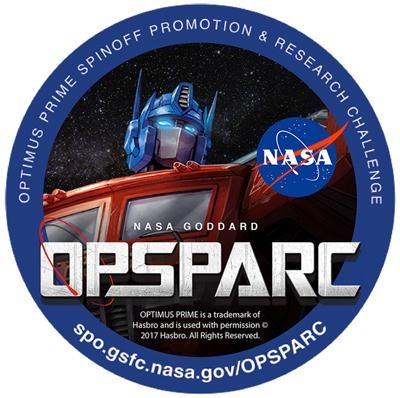OPSPARC 2019 Generated International Engagement From Students In The U.S., Canada (Excluding Quebec) And The U.K.
NASA has announced the winners of the OPTIMUS PRIME Spinoff Promotion and Research Challenge (OPSPARC) 2019. With hydroponic filtration systems, 3D bioprinters and pollution-mitigating masks, innovative students have once again dreamed up creative ways to change the world using NASA technology.

Just like OPTIMUS PRIME from the Transformers series, NASA spinoffs start off as one thing but can convert into something else. NASA technologies developed for space missions can be reimagined and put to use in a home, school or business. "This challenge encourages students to think like entrepreneurs, and they have definitely met that challenge head on," said Erin Majerowicz, OPSPARC program manager at NASA's Goddard Space Flight Center in Greenbelt, Maryland. "It's inspiring to see their creativity shine through to 'Be the Spark.'"
With three distinct missions, OPSPARC 2019 generated international engagement from students in the United States, Canada (excluding Quebec) and the United Kingdom. Challenge participants in Missions 2 and 3 picked from 20 NASA technologies to design their spinoffs.
Mission 1 challenged students of all ages to explore their world in search of spinoffs and submit them to NASA using Adobe Spark, a new OPSPARC collaborator. Morgan Cook from Saint Cloud, Minnesota, won for the month of January, and Justin Choi from Fullerton, California, won for the month of February. More winners will be selected and announced through the end of May 2019.
Mission 2 asked students in grades 3 through 12 to redesign a NASA technology and use it to solve a societal problem.
Fifth grader Samuel Kyong from Frank Lamping Elementary School in Henderson, Nevada, won in the elementary age group for his idea to use hydroponics as a filter for environmental volatile organic compounds. His project, called "Green Balance," leveraged the waste produced by fish to fertilize plants, which filter the air.
Linnea Mitchell, Molly Kernan and Kailyn Kim's project scored them the winning spot in the middle school age group. Using a sunshield coating from the James Webb Space Telescope, the eighth graders from Valley View Middle School in Snohomish, Washington, proposed to adapt the technology for covering house rooftops in countries with extreme heat.
For the high school age group, eleventh graders Mia Lorenzo and Jihee You and tenth graders Sarah Kim and Mirai Molde modified "Particle Contamination Mitigation Methods" to design dishes that clean themselves. Lorenzo attends Ed W. Clark High School in Las Vegas, Nevada; You attends Coronado High School in Henderson, Nevada; Kim attends West Career and Technical Academy in Las Vegas, Nevada; and Molde is from Las Vegas, Nevada.
Mission 3 gave students grades 7 through 12 the opportunity to take their spinoff ideas to the next level by developing 3D presentations and a marketing plan within a virtual world setting called InWorld OPSPARC.
In the middle school age group, eighth graders Natalie Evans, Zoey Stein, Kenda Eder and Alana Flores from Valley View Middle School in Snohomish, Washington won for their design of a face mask that filters harmful pollution from the air. Their mentor, Jomardee Perkind, supported the team as they adapted "Particle Contamination Mitigation," a technology from NASA's Langley Research Center.
Twelfth grader Bhoomika Kumar and tenth grader Vishal Sivamani won Mission 3's high school age group by designing a 3D bioprinter to generate biological tissues and prosthetics. Samantha Warner mentored the team in developing their concept, which was based on another Langley technology, the "NASA 3D Printer." Kumar and Sivamani are from Coppell High School in Coppell, Texas.
NASA has invited all winners to Goddard Space Flight Center in Greenbelt, Maryland for a two-day Winner's Workshop and Awards Ceremony. Students will meet NASA scientists, explore labs and see NASA facilities.
In addition to Adobe Spark, this year's OPSPARC collaborators include the National Institute of Aerospace, PRIVO, Mad Science, NASA Langley, the Foundation for Technology and Privacy Outreach, HubSpot, Tor Teen, the International Technology and Engineering Educators Association and Ministry of Supply.
OPSPARC 2020 starts in fall 2019 — updates will be announced on the OPSPARC website.
(Source: NASA news release)
 Airborne 04.16.24: RV Update, Affordable Flying Expo, Diamond Lil
Airborne 04.16.24: RV Update, Affordable Flying Expo, Diamond Lil ANN's Daily Aero-Term (04.20.24): Light Gun
ANN's Daily Aero-Term (04.20.24): Light Gun Aero-News: Quote of the Day (04.20.24)
Aero-News: Quote of the Day (04.20.24) Aero-News: Quote of the Day (04.21.24)
Aero-News: Quote of the Day (04.21.24) ANN's Daily Aero-Term (04.21.24): Aircraft Conflict
ANN's Daily Aero-Term (04.21.24): Aircraft Conflict



